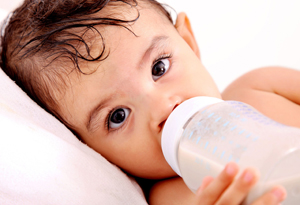
The vast majority of canned goods in the U.S. are sealed with resin that contains BPA to prevent contamination and spoiling. BPA is also used in many thermal paper cash register receipts and in some dental sealants.
by Mary Budinger —
The Federal Food and Drug Administration (FDA) announced July 17, 2012, that baby bottles and sippy cups can no longer contain bisphenol-A (BPA), the plastic chemical that was banned three years ago by Canada for use in baby bottles.
The American Chemistry Council asked the FDA to phase out rules allowing BPA in baby bottles and sippy cups after it determined last year that all manufacturers had already abandoned the chemical due to safety concerns.
FDA Deputy Commissioner Michael Taylor said the decision simply codified what the industry was already doing, based on the preference of consumers and did not reflect concerns about the safety of BPA in baby bottles or toddler’s cups. The decision “solidifies legally that the use will not happen again in the future in baby bottles,” he said.
However, the FDA “continues to support the safety of BPA for use in products that hold food,” said agency spokesperson Allen Curtis. About 90 percent of Americans have traces of BPA in their urine, mainly because the chemical leaches out of food and beverage packaging. The vast majority of canned goods in the U.S. are sealed with resin that contains BPA to prevent contamination and spoiling. BPA is also used in many thermal paper cash register receipts and in some dental sealants.
“Once again, the FDA has come so late to the party that the public and the marketplace have already left,” said Jason Rano, of the Environmental Working Group, which is pushing for a BPA ban in cans of infant formula, food and beverages.
BPA is known as an endocrine disrupter, meaning it can alter the structure or function of hormones — including those in the thyroid and reproductive system. Some studies also point to BPA exposure as being a cause of cancer, particularly prenatal exposure.
According to a new study published in the journal Environmental Science & Technology, bisphenol-S (BPS), the chemical now substituted in many “BPA-free” products, may be more harmful. The study found BPS is capable of absorbing into the skin at a rate up to 1,900 percent higher than BPA, which makes it potentially much more harmful than BPA in altering hormone levels. Other studies have shown that BPS is far less biodegradable than BPA and is actually the most persistent bisphenol compound among eight of the most common bisphenol compounds tested.
Bisphenols are part of a broad family of chemicals, each with different properties, but all potentially dangerous to humans. Bisphenol-AF is used in electronic devices, optical fibers, etc., and studies show it to be an even more potent endocrine disrupter than BPA. Bisphenol-B and -F are also frequently substituted for BPA. Bisphenol-B is potentially more potent than BPA in stimulating breast cancer cells.
Sources: New York Times, July 17, 2012, Science Daily, July 11, 2012, Alliance for Natural Health, June 26, 2012.
Mary Budinger is an Emmy award-winning journalist who writes about integrative medicine. 602-494-1999.
Reprinted from AzNetNews, Volume 31, Number 4, August/September 2012.





September 2, 2012
August/September 2012 Issue, Cancer, Chemical and Toxic Exposure, Food, Health